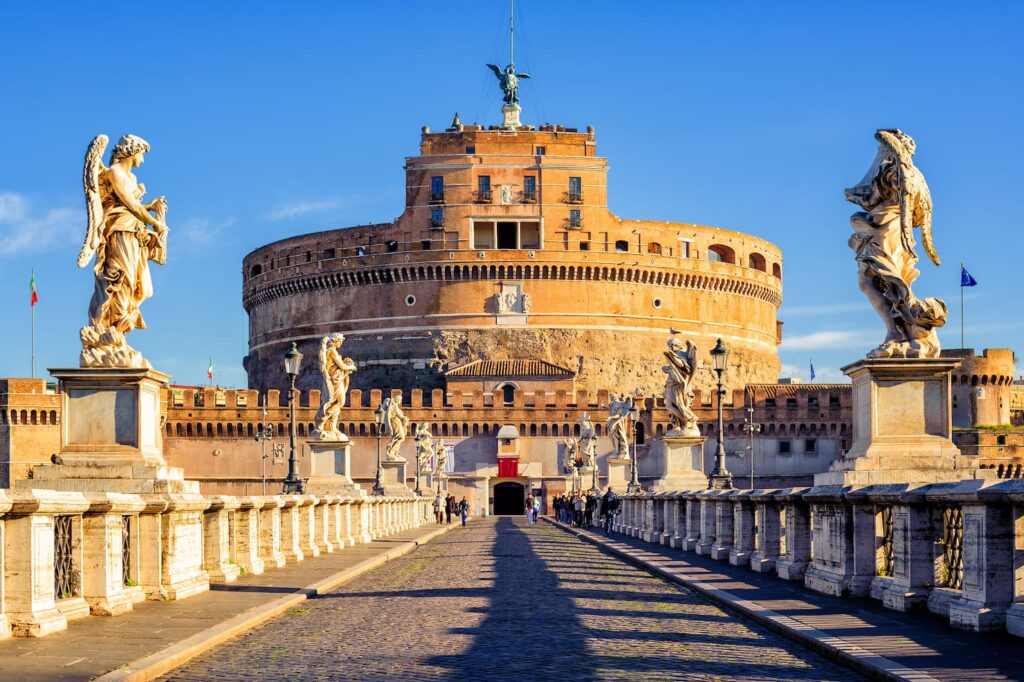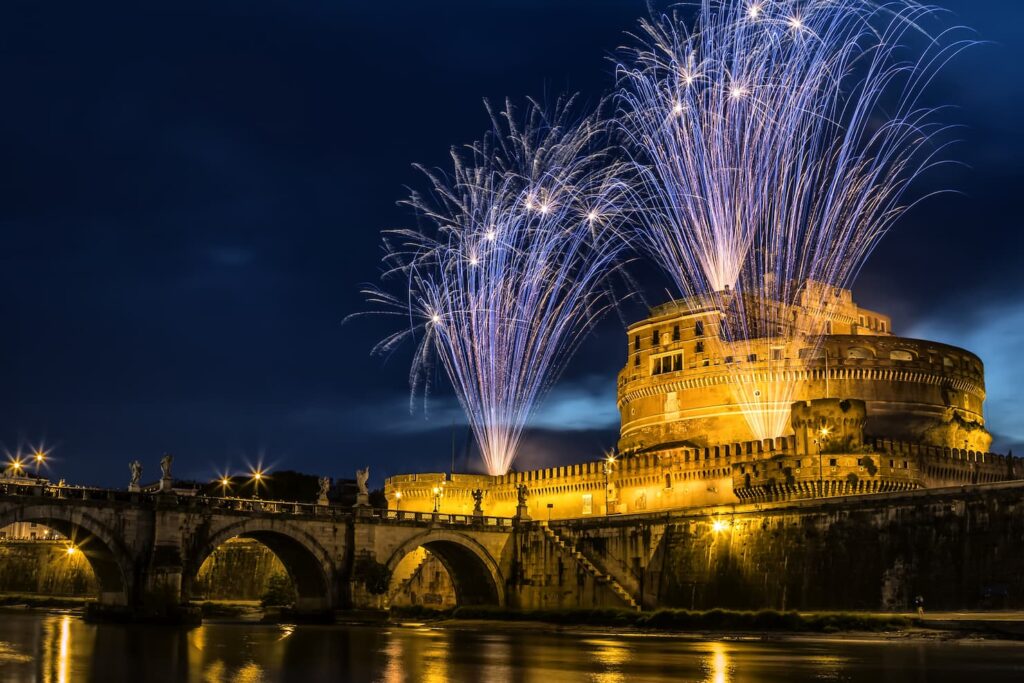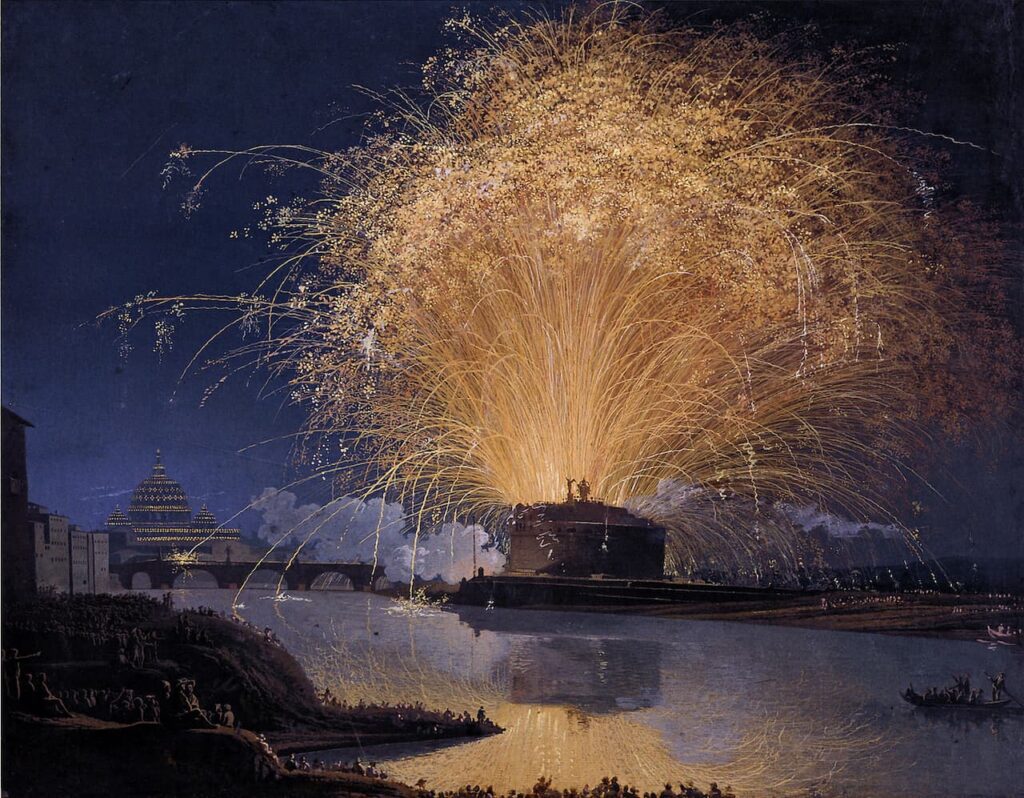The Girandola of Castel Sant'Angelo is Rome's great fireworks display held every June 29, in the feast of the Saints Peter and Paul.
The setting is Castel Sant'Angelo and the sky over the Tiber.
The show lasts about 20 minutes and uses "pinwheel" effects in a pyro-musical design designed for the city.
You can assist well from the Lungotevere Tor di Nona and from the bridges Victor Emmanuel II, Sant'Angelo and Umberto I.
In this article we find out together the best date, time and places from which to watch the event of the fires in Castel Sant'Angelo.

The best-selling ever
Castel Sant'Angelo: Entrance ticket + audio guide
Discover Castel Sant'Angelo on your own with quick access and audio guide on your smartphone. An interactive tour of the museum and historic rooms.
Secure payment
Immediate confirmation
Cell phone ticket
The fireworks at Castel Sant'Angelo

Dates and times
- Date: June 29, 2026
- Location: Castel Sant'Angelo, Lungotevere Castello 1, 30124 Rome (RM)
- Start time: 21:30
- Duration: about 20 minutes
The Girandola of Castel Sant'Angelo is held every June 29, on the feast of Saints Peter and Paul.
Start time is 9:30 p.m. and the total duration of the show is About 20 minutes.
If you wish visiting the museum Before or after the fires, keep in mind. at evening events the internal route may undergo variations or restrictions.
From where to watch the Girandola
For a view Frontal view of Castel Sant'Angelo and the Passetto di Borgo, the official recommended points are. Lungotevere Tor di Nona and bridges Victor Emmanuel II, Sant'Angelo and Umberto I. They are wide overlooks with direct views of the show set.
If you prefer a more secluded but scenic spot, you can look for a shot from the Janiculum or from the heights around Piazza del Popolo and Villa Borghese. The distance is greater, but the skyline with the Castle and the dome of St. Peter's is very photogenic.
Consider the flow management: on the evening of June 29, the area can provide. transit bans and restrictions On the Tiber Promenade and around the Castle. Arrive early and follow the signs to Rome Mobility and Local Police.
A useful little trick is to choose a spot without trees or streetlights in the firing line, to take into account the wind to avoid backlight smoking and to carry a water bottle.
If you want to take pictures, the bridges mentioned above offer stable framing On the river and the profile of the Castle.
How the Girandola works
The Girandola is constructed as a pyro-musical design in several "pictures." opening, series of color pinwheels and grand finale. The most anticipated moment is the "ultimate fountain", a diffuse jet that looks like embrace Castel Sant'Angelo.
The name is not accidental. In pyrotechnics, "Girandola" means a rotating fire around a pivot, the classic wheel of light that generates fans and spirals. Today these effects are synchronized to the millisecond with music and the score of kindling.
Historically, the "fire machine" was set up on the Angel Terrace.
The power of the sparks was such that, in the rooms below such as the Hall of Columns, they installed removable flaps at windows to protect them during the performance. It is a concrete trace of how the party dialogued with the architecture of the castle.
Today it is directed by architect Giuseppe Passeri with INVICTA & Co Group IX.
The National Museums Directorate of the City of Rome and Roma Capitale. coordinate safety, timing, and logistics, so as to ensure execution compact (about 20 minutes) and an optimal view from Lungotevere Tor di Nona and the bridges indicated.
If you want to find out the documents, prints and historical "machines" related to the Girandola, there is a permanent installation in the Castellan's Apartment.

The best-selling ever
Castel Sant'Angelo: Entrance ticket + audio guide
Discover Castel Sant'Angelo on your own with quick access and audio guide on your smartphone. An interactive tour of the museum and historic rooms.
Secure payment
Immediate confirmation
Cell phone ticket
The Story of the Girandola of Castel S.Angelo

Renaissance origins
The Girandola was born in the Renaissance Rome.
The chronicles place it in 1481, under Pope Sixtus IV, when the "fire machines" to the best wits of the age.
Tradition attributes the stage conception to Michelangelo Buonarroti; in the baroque age Gian Lorenzo Bernini enriched games of lights, colors and sounds, even drawing inspiration from the power of the volcano of Stromboli.
For centuries, the natural stage of the party was just Castel Sant'Angelo: the design culminated in the famous "ultimate fountain" that seemed to gush from the monument, in front of the Tiber and the city's historic bridges.
The physical venue for the performance was the Angel Terrace, where the fires were held From the Renaissance to the nineteenth century.
Even today, the museum still recounts that tradition: in theCastellan's apartment find a permanent exhibition dedicated to the Girandola.
Nineteenth and twentieth centuries
In the late nineteenth and early twentieth centuries, the Girandola was suspended.
The fires, exploded on the Angel Terrace, caused extensive damage to stucco and frescoes Of the environments below.
For monument protection and safety, the show was discontinued and fell into oblivion.
The re-enactment restarts in 2006 on Vatican Hill for the 500 years of the Papal Swiss Guard. It is a symbolic choice, linked to the anniversary, reviving the original idea with a philological reconstruction.
Since 2008, the show has returned to Castel Sant'Angelo, where it remains until 2016.
In that year he is moved to the Pincio Terrace for broader flow management and for reasons of public safety, with contingent access plans and dedicated garrisons.
From 2021, the Girandola returns to the Castle and is consolidated as a permanent fixture of the June 29.
In 2024 the museum dedicates the exhibition to the event "The marvel of time. The Girandola and Pyrotechnic Art at Castel Sant'Angelo.", core of the current permanent display in the Castellan's Apartment.
The Girandola in Art

Hackert, Feuerwerk auf der Engelsburg in Rom - Jdsteakley via Wikimedia
The Girandola has ignited the imagination of engravers and painters.
In the eighteenth century the Vedutism turned it into a nighttime icon of Rome: it was enough to the silhouette of Castel Sant'Angelo reflected in the Tiber and the final fountain Of sparks to tell the whole city.
Official records recall how the party was portrayed and narrated during the Grand Tour, which has entered fully into the European imagination.
Among the most famous images is the large color etching designed by Louis-Jean Desprez and engraved by Francis Piranesi, with the bridge packed and the carriages in the front row. It is a theatrical scene, designed to capture the climax of the grand finale. Exemplars of it are preserved in the Metropolitan Museum, the British Museum, the Yale University Art Gallery and the Rijksmuseum.
In 1775, the landscape architect Jakob Philipp Hackert paints the fires above the Mole Adriana, fixing the Roman night with almost documentary precision. The canvas is also known today through public digital collections.
A few years later, Joseph Wright of Derby interprets the Girandola with Enlightenment flair: a whimsy of monuments and glows that makes the event a laboratory of artificial light and modernity.
In the 19th century, the Italian Ippolito Caffi returns the party with cut reportage, amid vapors and reflections on the river. The Thorvaldsens Museum documents one of his views of the Girandola executed in the early 1930s of the century.
Experiencing the Girandola safely
On the evening of June 29. the area around Castel Sant'Angelo fills up.
Choose in advance a point with unobstructed view and keep in mind the recommended viewpoints: Lungotevere Tor di Nona and bridges Victor Emmanuel II, St. Angel e Umberto I. These are the overlooks also indicated on the official pages Of the event.
Put into account changes to the road system. In recent years, in the afternoon-evening the following have been activated transit bans e reroute bus routes in the Castle area and along Vittorio Emanuele II course.
Typical example: from the 19.30 trigger bans and Detours for routes 23, 30, 34, 40, 46, 62, 64, 98, 115, 280, 870, 881, 916F; the 190F is often limited. Always check the updates of the day at Rome Mobility e ATAC Before you move.
Arrive early and, if you can, use subway and train to approach you, then continue on foot. Follow the prepared routes and directions of the Local police along the bridges and the Lungotevere.. At the end of the show, wait for the flows to flow out and use the fermant alternatives suggested in real time by official channels.

The best-selling ever
Castel Sant'Angelo: Entrance ticket + audio guide
Discover Castel Sant'Angelo on your own with quick access and audio guide on your smartphone. An interactive tour of the museum and historic rooms.
Secure payment
Immediate confirmation
Cell phone ticket
Fireworks over Castel Sant'Angelo: FAQ
It is generally always held on June 29, during the feast of Saints Peter and Paul.
It starts at 9:30 p.m. and the average duration is about 20 minutes.
Recommended overlooks are Lungotevere Tor di Nona and the Vittorio Emanuele II, Sant'Angelo, and Umberto I bridges. Frontal views of Castel Sant'Angelo and the Tiber.
The show is outdoors and can be followed from the public areas indicated above. No ticket is needed to attend. If you want to enter the museum instead, there is a charge for access with official fees.
Normally not: the official view is from the outside. Also, during evening events the museum route may have variations or restrictions. Always check museum notices.
"Girandola" is the name of a rotating fire whose tradition has its roots in 1481. The scenic idea is attributed to Michelangelo, later enriched by Bernini.
The historical reenactment stops at the end of the 19th century. Museum sources recall that the fires, which exploded on the Terrace of the Angel, even required removable flaps on the windows of the Hall of Columns to protect them-a sign of damage and risk to the rooms below.
From 2016 to 2019, the reenactment was held on the Pincio Terrace for reasons related to safety & security management of events in the square.
As of 2021, the Girandola is back in Castel Sant'Angelo.
This is an outdoor event. Times and modalities may vary due to weather or public safety reasons: check the same day on official Turismo Roma and Museums Direction channels.
Yes, but choose areas that are not too crowded, bring sensitive ear protection, and stay away from the barriers. Official spots on the riverfront and bridges provide space and visibility.
Course. Visit Castel Sant'Angelo in the afternoon and then stay for the evening show. Remember that in the evening the interior route may vary. Book early to avoid lines.